The Two Phases of the Housing Bubble: Part II

Part I of this Commentary documented how families found it increasingly difficult to afford rapidly-appreciating houses from mid-2003 through mid-2006. It showed how mortgage securities issued by Wall Street – Private-Label Securities (PLS) – increased their market share from the Government National Mortgage Association (GNMA) and from the government sponsored enterprises (GSEs – Fannie Mae and Freddie Mac).
Coincident with the growth of the PLS market was the explosion in nontraditional mortgage products which were mostly adjustable-rate mortgages (ARMs) of various types as compared to the fixed-rate mortgages (FRMs) that GNMA and the GSEs specialized in. The difference in product mix between the GSEs and PLS is shown in Exhibit 1 and the difference in relative performance is in Exhibit 2.
Over the 2004-2006 period, less than one-fifth of the loans backing newly-issued GSE mortgage-backed securities (MBS) were adjustable-rate mortgages. In contrast, almost three-quarters of the loans packaged in PLS were ARMs (Exhibit 1).1
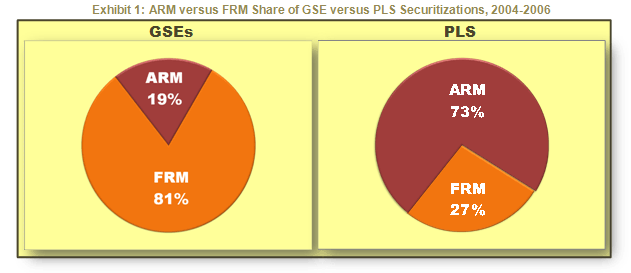
Exhibit 2 compares serious delinquency rates for GSE-financed versus PLS-financed loans by ARM or FRM product line. It shows the percent of such loans that were originated in the 2004-2006 period and which had been 90 or more days past due at any date before the end of 2009. For fixed-rate mortgages, the PLS delinquency rate was three times the GSE rate (22.1% versus 7.4%). For adjustable-rate mortgages, the ratio for PLS was 2.6 times that for the GSEs (32.3% versus 12.6%). This works out to an overall delinquency ratio for PLS loans that was 3.5 times worse than for GSE loans (29.5% versus 8.4%).
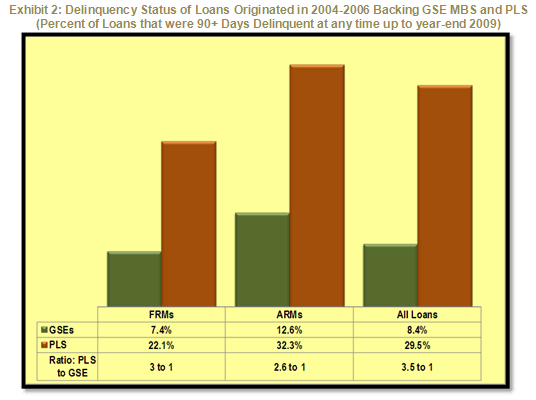
The reason that the ratio of PLS to GSE delinquency rates for total loans was even worse than the ratio for either of the constituent FRM or ARM classes is that the PLS ARM loans with their high delinquency rate (an average rate of 32.3%) made up 73% of PLS loans while ARMs with an average delinquency rate of 12.6% made up only 19% of GSE loans.2
This shows that PLS loans performed much worse than GSE loans because of both an unfavorable product mix and inferior performance within each product class. We will see below that this dynamic goes much further down to an even deeper granular level than just the FRM/ARM divide.
Outside of the ARM/FRM disparity between the two sectors, another explanation for the difference in loan performance between GSE MBS and PLS is the difference in risk characteristics in the loans backing each type of security.
The next two exhibits break down the loans in each sector by two common underwriting criteria – the amount of a down payment the borrower made and the borrower’s credit score. Exhibit 3 groups the data by the down payment3 and Exhibit 4 takes the same data and groups them by credit score.4
A loan-to-value ratio of 80% or less (or a down payment of 20% or more) is the customary breakpoint used in the industry to determine the safest category as far as LTVs go.5 For the GSEs, 84% of loans fell in this category compared to 72% for PLS (Exhibit 3). For credit scores, 660 is often regarded as the threshold for the safest loans and the difference here is even more striking than with LTVs – 83% of FICOs for GSE loans were above 660 compared to 49% of PLS loans (Exhibit 4).6
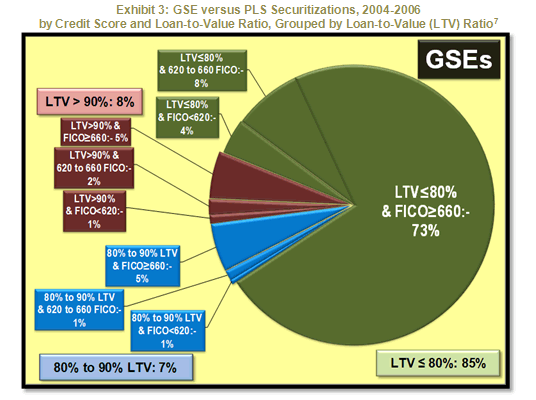
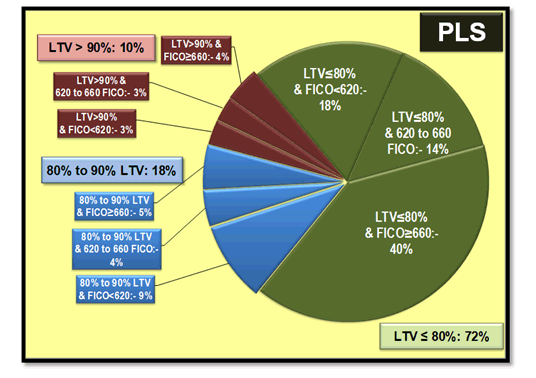
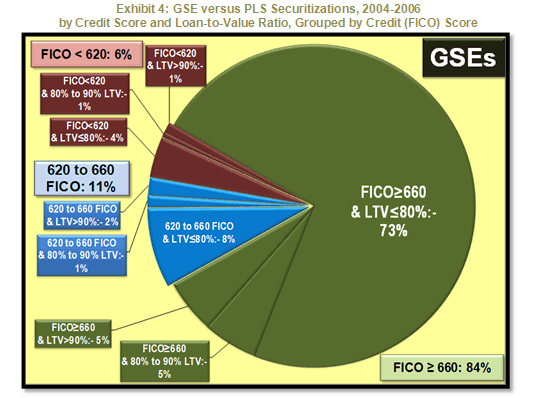
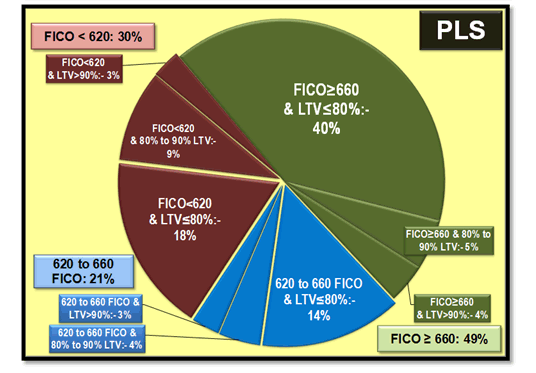
Putting the two criteria together, 73% of GSE loans had LTV ratios of less than 80% and FICO scores greater than 660. For PLS, the percentage is 40%.
At the other end of the spectrum, there was not much difference in the percentage of loans with LTVs greater than 90% – 8% for the GSEs versus 10% for PLS (Exhibit 3). However, there was a major difference in the lowest credit score category – 6% with a FICO score less than 620 for the GSEs versus 30% for PLS (Exhibit 4).
If we dig down deeper into the FHFA data and control for these underwriting criteria, the pattern that is shown in Exhibit 5 emerges. This looks at how GSE loans performed versus PLS loans if we slice the data by the LTV and FICO underwriting criteria that FHFA provides.
Exhibit 5 divides both FRM and ARM loans (as well as combined total loans) into nine separate buckets using a 3x3 grid formed from three LTV ranges and three FICO score ranges (not counting the cells for sub-totals and totals). With nine buckets for FRMs and nine for ARMs, there are a total of 18 independent cells in the table in Exhibit 5 (the nine non-shaded cells for both FRMs and ARMs).
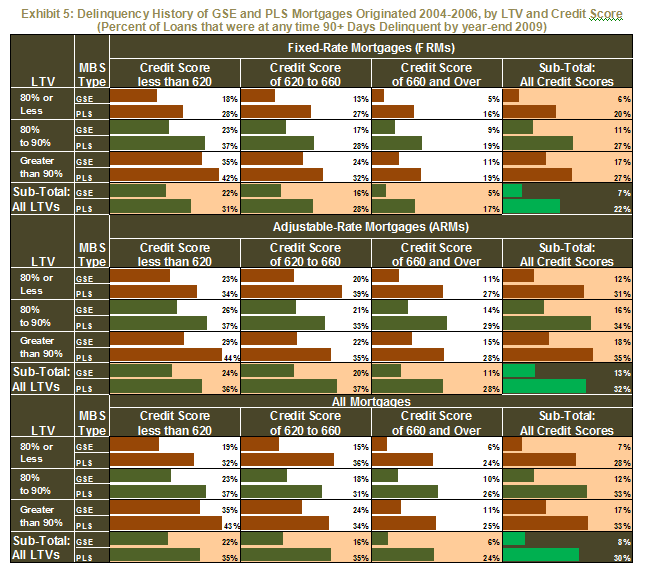
In every one of the 18 cells, the serious delinquency rate for loans pooled in GSE MBS is less than the corresponding cell for loans backing PLS.
For fixed-rate mortgages the difference between the delinquency rates runs from a minimum of six to a maximum of 14 percentage points. For adjustable rate mortgages, the difference ranges from a minimum of 10 to a maximum of 19 percentage points. And, because of the added element of the dissimilar product mix, the difference for the overall total is 22 percentage points (30% for PLS versus 8% for the GSEs).
The differences in credit performance between loans backing PLS and GSE MBS are clear. The analysis in this Commentary shows that three developments help explain the wide divergences in the performance numbers:
- As houses were becoming less affordable in the second and more problematic phase of the housing bubble (mid-2003 to mid-2006), PLS took market share from the GSEs;
- As PLS issuers became more prominent, the product mix of loans financed by PLS included more risky characteristics than GSE-financed loans; and
- Within each risk bucket during the second phase of the housing bubble, the GSEs had tighter eligibility and underwriting standards than the sponsors of PLS.
Noel Fahey
Director, Economics and Strategic Research
March 9, 2012
The views expressed in these articles reflect the personal views of the authors, and do not necessarily reflect the views or policies of any other person, including Fannie Mae or its Conservator. Any figures or estimates included in an article are solely the responsibility of the author.
1 Source for all of the data in Part II of this Commentary is from the Federal Housing Finance Agency (FHFA) based on Appendix Tables B-1 and B-3 at https://www.fhfa.gov/Default.aspx?Page=313.
2 The delinquency rate for total loans for both the GSEs and PLS is a weighted average of the delinquency rates for FRMs and ARMs. For the GSEs, this works out to be: 7.4% X 81% + 12.6% X 19% = 8.4%. For PLS, it is: 22.1% X 27% + 32.3% X 73% = 29.5%.
3 Actually, employing the usual convention in the industry, the complement to the down payment is used – the amount of the loan as a percent of the value of the property, the loan-to-value (LTV) ratio. An LTV ratio of 80% means that the borrower made a down payment of 20% of the value of the property.
4 The credit score is the FICO® Score developed by the Fair Isaac Corporation. The score ranges between 350 and 850. See https://www.myfico.com/Downloads/Files/myFICO_UYFS_Booklet.pdf.
5 For instance, the Fannie Mae Charter Act (https://www.fhfa.gov/GetFile.aspx?FileID=29) requires the company to acquire credit protection from a qualified insurer on the amount of any mortgage it purchases that is in excess of 80% LTV.
6 For example, the Fair Isaac Corporation, the creator of FICO scores, defines 660 as the threshold for a “good” FICO score (see https://scoreinfo.org/FICO-Scores/What-Score-Means.aspx).
7 The LTV ratios shown do not capture any second liens secured by the property that were present at origination.
